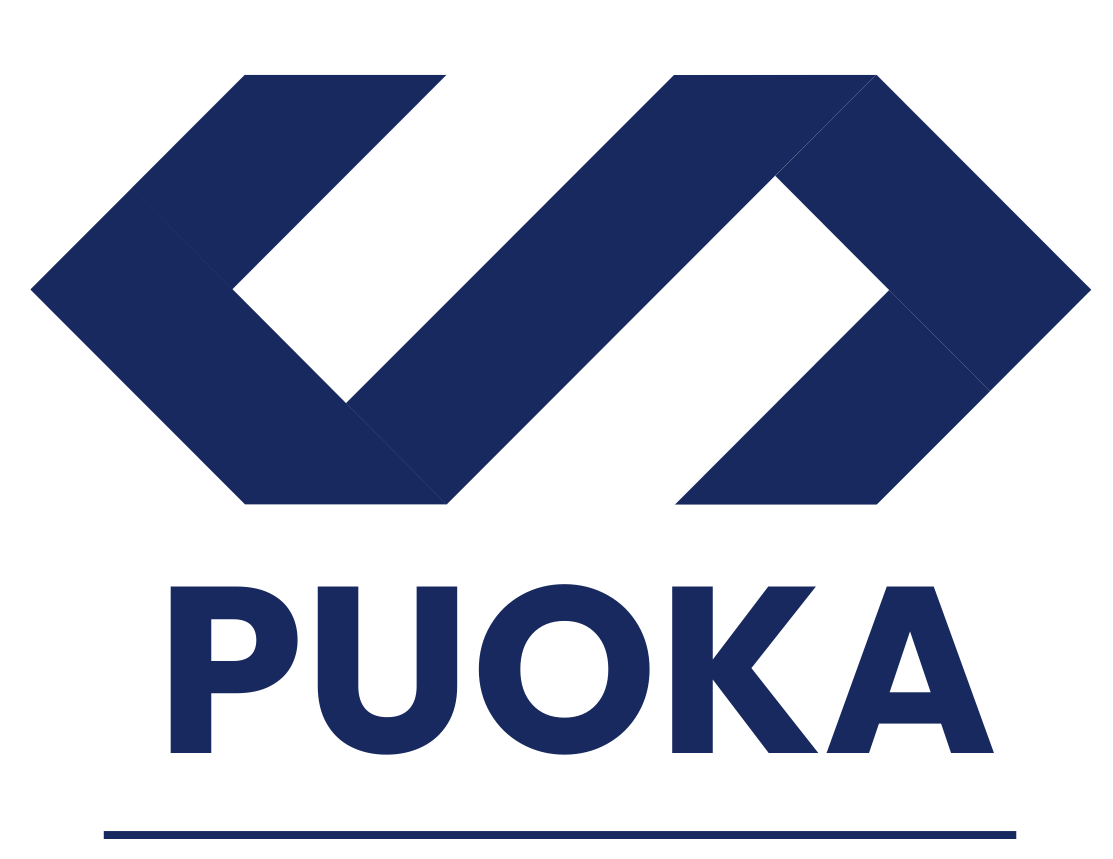Most employees today use digital tools — even when not all of them are working remotely.
Imagine a company’s digital environment as a high-tech, well-designed office where everything — from communication tools and project management systems to virtual meeting spaces — is thoughtfully arranged to help employees collaborate efficiently.
If this digital environment is poorly designed or hard to navigate, it’s akin to having a cluttered and uncomfortable physical office, which can hinder productivity and job satisfaction.
In this digital employee experience guide, I’m showing you how you can prevent that.
What is the digital employee experience?
Think of the digital employee experience (DEX) as a “digital workspace” or “virtual office” that employees interact with daily. Just as a physical office space influences how productive and comfortable our employees feel at work, the digital platforms they use shape their work experience, and how they remember their employer.
Research shows that employees who have a positive experience at work are 16 times more engaged than those with a negative experience, and they’re eight times more likely to remain with the company.
It’s all about creating a cohesive experience where employees will find it easy to access information, collaborate with colleagues, and stay connected to the company’s mission, no matter where they’re working from. As digital tools become ubiquitous for in-office, remote, and on-site employees, investing in a positive DEX is essential for maintaining high morale and efficiency.
What is the difference between digital employee experience and employee experience?
A traditional employee experience reunites a mix of strategies companies use throughout the entire employee journey, regardless of a worker’s location. This includes every detail of their work life, from the initial onboarding stages to daily tasks and career advancement opportunities. Historically though, employee experience involved physical work environments, company culture, management practices, and personal interactions.
A digital employee experience appeared as a subset of employee experience management as we once knew it. The digital side focuses on the digital aspects of the employee lifecycle. Employees now interact with digital tools, handling work execution, collaboration, and even operations — virtually. All of this requires a separate set of policies and strategies to ensure the functionality and integration of these digital tools in employees’ daily lives.
Both are crucial though. If you were to focus on building a positive digital employee experience alone, you’d miss out on leveraging classic opportunities to enhance productivity and satisfaction. The reverse is also valid.
Why is a digital employee experience important?
A proper digital employee experience ensures that digital tools are intuitive and seamlessly integrated, which helps employees stay connected and engaged. When employees have easy access to the information and resources they need, they’re more likely to feel involved and motivated in their work, increasing engagement levels.
A study by Shelley Xin Li and Tatiana Sandino examined the impact of an Information Sharing System (ISSC) on employee creativity, engagement, and financial performance within a mobile phone retail chain in India. The research revealed that the ISSC had a positive effect on both engagement and creativity, especially in stores with previously lower levels of creative talent and those in diverse markets needing greater customization.
Effective digital tools also play a significant role in enhancing productivity. They streamline workflows, minimize friction, and reduce the time spent on repetitive tasks. When technology supports daily activities rather than impeding them, employees work efficiently, resulting in higher productivity and job satisfaction.
Fresca experienced a notable surge in employee engagement, witnessing a remarkable 54% increase in interaction levels after implementing a new communications app.
In hybrid and remote work settings, where digital interactions are the lifeline, a strong digital employee experience becomes even more important. It can improve business outcomes by facilitating efficient remote interactions and better project results, which enhances performance and can give your company a competitive edge.
Engaging remote employees effectively begins with robust communication, including regular check-ins, clear communication channels, and mechanisms for gathering and addressing feedback on their digital experience.
Benefits of digital employee experience
A well-designed digital employee experience offers several specific advantages, including improved communication, increased efficiency, higher employee morale, and reduced turnover:
- Improved communication: Effective DEX platforms enhance communication channels, making it easier for employees to stay connected and collaborate. For example, companies that implement advanced communication tools often see a marked improvement in team collaboration by as much as 10%.
- Higher employee morale: A thoughtfully designed DEX reduces frustration and enhances the overall work experience. For example, companies like The Social Hub have reported improved morale and engagement scores after investing in user-friendly and integrated digital platforms.
- Increased efficiency: Employees are 230% more engaged at work when they feel they have the right IT services and technology supporting them. Streamlined digital tools and integrated systems reduce friction and automate routine tasks, allowing employees to focus on more strategic work.
- Reduced turnover: A positive DEX can significantly impact employee retention by creating a supportive and engaging work environment. Team Cowabunga provides a well-defined career path, equipping employees with the tools and opportunities for advancement. Communicating these opportunities clearly to all employees was an essential step in their efforts to retain their top talent and minimize the time and costs associated with onboarding new team members.
How to build an effective digital employee experience strategy
Here’s a step-by-step guide I recommend for creating a successful DEX strategy:
- Conduct an audit: Start by assessing your current digital tools and platforms. Review how well they meet employees’ needs and identify any gaps or pain points. The level of detail in your analysis depends on your industry too. Seaboard Triumph Foods can easily stay up-to-date with compliance audits that are crucial to the food manufacturing industry.
- Set SMART objectives: Define clear, measurable goals for your DEX strategy. Objectives might include improving communication, enhancing productivity, increasing employee satisfaction, or reducing turnover. Ensure that these goals align with overall business objectives and address the issues identified in your audit. For the BayWa AG team, simply strengthening their connection with employees aligns with BayWa’s mission: “Doing what really matters.”
- Choose the right tools: Select digital platforms that can help you reach your objectives and address the needs identified in the audit. Consider factors such as ease of use and integration capabilities as well as what common use cases you’ll have.
- Involve employees in the process: Engage employees in the development and implementation of the DEX strategy to ensure transparency and buy-in. This involvement helps to ensure that the tools and processes meet their needs and fosters a sense of ownership.
- Time to implement your strategy: Roll out the chosen tools and processes. You’ll want to have the right training and support materials in place to help employees transition to the new systems. Don’t forget to develop a clear change management plan. This should include communication strategies to inform employees about what’s changing, why it’s changing, and how it will benefit them.
- Monitor and tweak as you go: Continuously track the effectiveness of your employee digital experience strategy by collecting feedback and analyzing usage data. Be prepared to adapt your strategy based on evolving needs and technological advancements.
Examples of digital employee experience
With so much to do, let’s see a couple of ways in which you can implement a digital employee experience for different industries and company types.
Remote onboarding with Bethany Children’s Health Center
Industry: Healthcare
Company size: 1000+
Bethany Children’s Health Center, a leading pediatric rehabilitation facility, successfully implemented remote onboarding through its employee app to address several key challenges. With a predominantly remote workforce and the need for effective communication across various shifts, Bethany Children’s required a solution that could enhance engagement, ensure information accessibility, and meet stringent security standards.
Before creating Buzzcom through Staffbase, communication at Bethany Children’s was fragmented, with departments working in silos and information not reaching staff on time. The introduction of their internal app addressed these issues by providing each department with its own hub for streamlined updates. This system enabled quick access to necessary information, increased efficiency, and allowed healthcare professionals to focus more on patient care.
100% of employees registered on the app, 80% were onboarded within six months, and 80% of staff remained active users. The app facilitated effective crisis communication, such as issuing alerts during a water safety advisory, and played a significant role in fostering a strong company culture through features like the Social Wall and departmental updates. The success of this new app earned Bethany Children’s recognition with Ragan’s 2023 Crisis Communications Award in the Healthcare Industry.
Internal communication with Dishoom
Industry: Hospitality
Company size: 1750+
Dishoom, a renowned Indian cuisine restaurant chain, transformed its internal communication in 2021 to address challenges related to diverse and outdated methods, high costs, and inadequate engagement tracking. Previously relying on internal emails, town hall meetings, and costly printed materials, Dishoom faced issues with engagement data and outdated channels, particularly Facebook.
To tackle these challenges, Dishoom adopted the Staffbase app, which offered integration with their scheduling system, targeted push notifications, and features like “Journeys” for improved communication. The implementation included creating mobile-friendly content, segmenting messages, and engaging key decision-makers, including the Director of HR. The app, named Dishoom Wallas, was launched with excitement, featuring a surprise reveal and celebration.
Dishoom achieved a 97% registration rate and 50% weekly active users. The app facilitated high user engagement with substantial user-generated content and a successful referral program, contributing to increased employee satisfaction and job retention. The centralization of information and introduction of interactive features, such as daily trivia quizzes, significantly enhanced communication and employee morale.
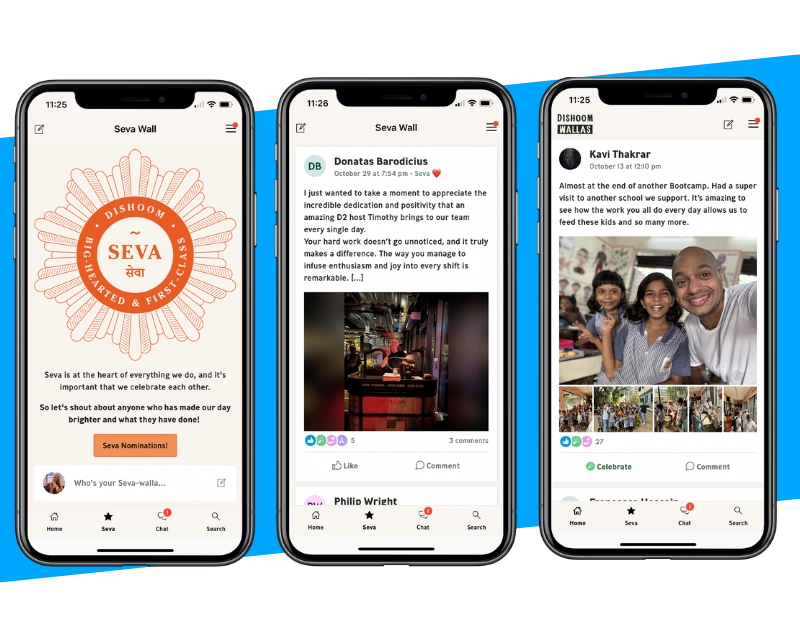
Connecting with non-desk workers with ALDI Australia
Industry: Retail
Company size: 16,000+
ALDI Australia, a major player in the grocery market, faced significant challenges in effectively connecting with its largely non-desk workforce. To address these challenges, they introduced MyALDI, a branded employee app launched in October 2021.
The app was designed to make communication easier and improve employee experience for remote workers by delivering real-time, segmented messages and providing a centralized platform for payroll, rostering, benefits, and more. This shift aimed to reduce the administrative burden on store managers and ensure that employees received consistent, relevant information efficiently.
MyALDI achieved a 99% registration rate, with 94% of users actively engaging monthly and 84% weekly. The app’s integration with HR systems and its ability to centralize employee services have improved engagement and led to significant cost savings. Additionally, the app facilitates valuable employee feedback, helping ALDI Australia better understand and respond to the needs of its workforce.
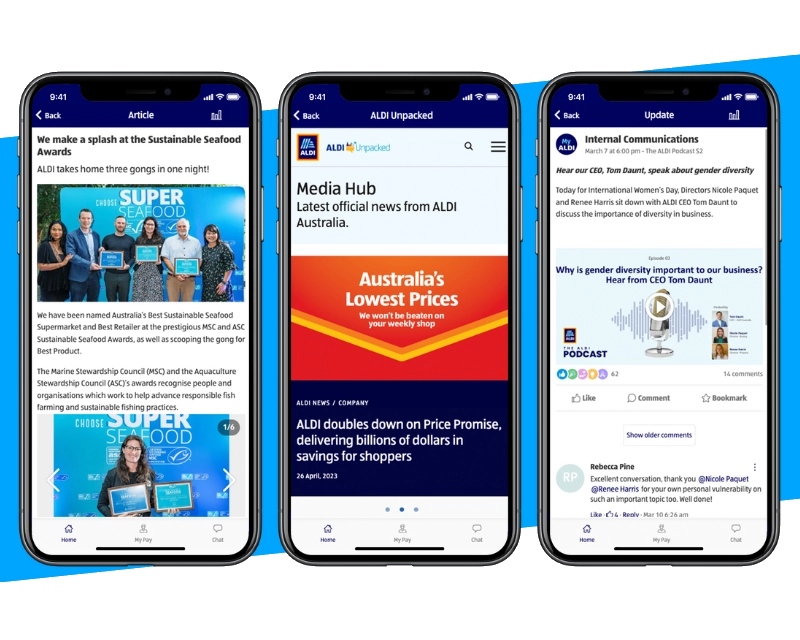
Getting employees to interact more with Geberit
Industry: Production
Company size: ca. 12,000
Geberit’s intranet, GIN (Geberit Intranet), aims to enhance employee interaction by providing mobile access and user-friendly features. Launched to connect the company’s 12,000 employees across 50 countries, GIN facilitates engagement through likes, comments, and surveys, making internal communication more inclusive, especially for blue-collar workers.
Internal communicators are now responsible for both strategic and operational aspects of the intranet, supporting stakeholders in creating targeted content and using the tool effectively. Feedback analysis helps tailor future content and features, aligning workforce needs with technical capabilities to maximize relevance.
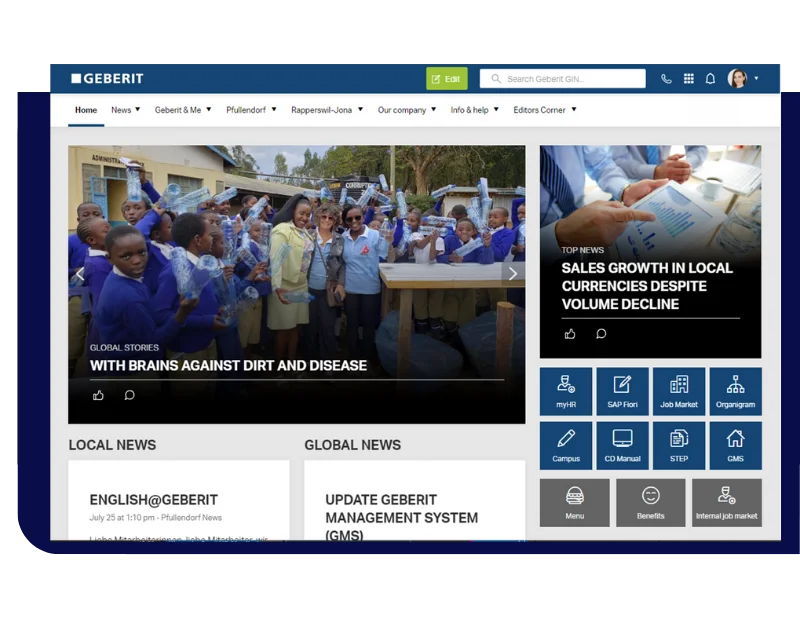
The role of software in shaping digital employee experience
Technologies like intranets, employee apps, and HR software are vital for enhancing digital employee experiences.
Intranets provide a centralized platform for internal communication and collaboration, making it easier for employees to access important information and engage with the company. Use an intranet if you’re currently struggling with scattered information or want a better method for facilitating knowledge and file sharing. An intranet also works wonders if you want an engaging digital work environment. That’s because you can use it to create interaction opportunities like forums, social feeds, and recognition systems.
Employee apps improve accessibility and convenience by offering mobile-friendly features for communication, self-service tasks, and real-time updates. By all means, companies with remote or no-desk workers must implement an employee app. This will speed up self-service tasks such as submitting leave requests, accessing pay stubs, or updating personal information.
HR software gives managers better control over administrative processes and provides employees with easy access to HR functions, contributing to a seamless digital experience. A complete HR suite is needed by most teams since most will help you cover diverse people operations use cases (e.g., onboarding, payroll, compliance).
Together, these tools create a cohesive and engaging digital environment, boosting employee satisfaction and productivity. But they’re not easy to choose and implement given you’re likely to bump into a couple of common challenges.
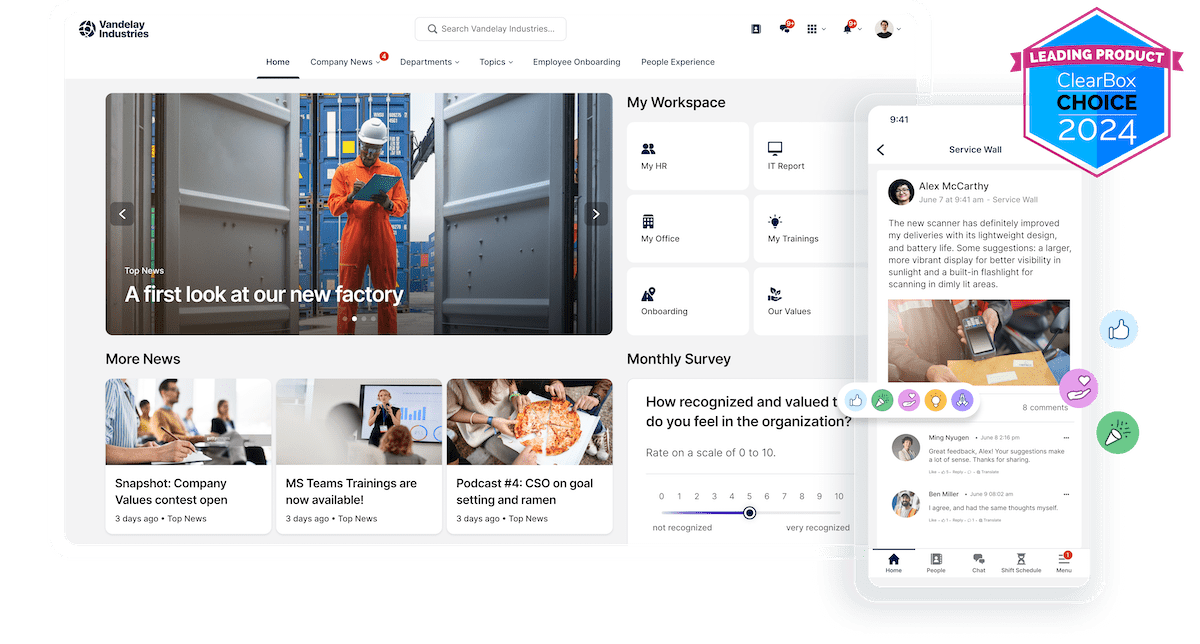
Challenges in implementing digital employee experience
The process of implementing a successful digital employee experience can face several obstacles. Here’s how to handle each:
- Dealing with legacy systems: Outdated technology can hinder new digital tools. A survey by S&P Global found that 52% of managers identified outdated technology as a significant recruitment challenge, even exceeding concerns about flexible work expectations. Solution: Gradually upgrade systems and use integration solutions to bridge gaps.
- Resistance to change: Employees may resist new technologies if they have been poorly informed about them. Solution: Communicate benefits clearly, provide training, and involve employees early in the process. During the pandemic, Brussels Airlines introduced a social wall within their app to replace lost physical spaces for employee interaction. This enabled staff to share thoughts and insights, fostering a sense of community while preventing external leaks of sensitive information.
Have a look at our change management strategy recommendations to help you with specific challenges.
- A lack of integration: Disjointed systems lead to inefficiencies. And research in the space is stressing the importance of integrating workplace technologies to enhance digital experiences. Solution: Choose tools with strong integration capabilities and use middleware to connect systems.
- Navigating a lack of communication: Poor communication always impedes DEX efforts. Solution: Use comprehensive intranet and employee apps for consistent, timely messaging and encourage employee feedback. SAK Construction handled the lack of communication that was posing safety threats in their industry through a newly introduced employee app.
How to improve digital employee experiences
Beyond solving its challenges, you should always focus on improving your DEX process.
To improve the digital employee experience, regularly collecting feedback from employees is essential for understanding their needs and experiences. Surveys, digital suggestion boxes, and feedback forms help gather valuable insights, with anonymous tools like online surveys ensuring employees can share honest opinions without fear of reprisal.
Providing continuous training is crucial as technology and processes evolve. Regular updates to training programs ensure employees stay current with new tools, features, and best practices. Offering diverse learning opportunities (e.g., online courses, webinars, and hands-on workshops) accommodates different learning styles and helps employees effectively leverage digital tools.
As your company grows, it’s important to regularly evaluate and upgrade your technology. Assess your digital tools and infrastructure to ensure they meet current demands and support scalability. Staying informed about emerging technologies and trends will help you plan for necessary upgrades or replacements, preventing obsolescence and maintaining a smooth digital environment. Investing in scalable solutions and integrating new technologies can enhance functionality and user experience.
Fostering a culture of digital innovation and collaboration can make employees feel empowered to experiment with new tools and share their ideas. Encourage cross-departmental collaboration through digital platforms that support teamwork and knowledge sharing. Recognize and reward innovative use of technology and collaborative efforts, and ensure leadership actively supports and models digital adoption, setting a positive example for the organization.
The future of digital employee experience
Artificial Intelligence (AI) is completely transforming the digital employee experience through personalized content creation. Generative AI tools enhance communication by tailoring content to individual employees’ needs and preferences. This approach fosters a more inclusive and engaging workplace environment, ensuring that messaging resonates with a diverse workforce.
Companies are shifting from basic chatbots to advanced, AI-powered experience platforms. 73% of American businesses currently use or plan to implement AI-powered chatbots for instant messaging. These systems provide personalized support with greater context awareness, while hyper-personalization and predictive analytics leverage data to offer tailored recommendations and improve team dynamics.
60% of people prefer mobile apps over websites thanks to their convenience. So businesses are adapting and prioritizing mobile-first solutions to optimize digital employee experiences. By focusing on mobile accessibility, companies ensure faster load times and intuitive navigation, making it easier for employees to engage with platforms on the go. This shift reflects the growing need for seamless, mobile-optimized tools in today’s fast-paced work environments.
Additionally, advanced technologies like AR (Augmented Reality) and XR (Extended Reality) are transforming virtual collaboration and training by offering immersive, interactive experiences. AI and IoT further enhance DEX by personalizing digital interactions and using smart sensors to create responsive, adaptive workplaces that monitor and adjust environmental conditions.
AI is also used to monitor and support employee mental health by offering personalized insights and early intervention systems. IoT devices improve workplace well-being by enhancing environmental factors like air quality and temperature control. Lastly, virtual reality plays its part in making mental health services more accessible, providing support even when traditional care options are limited.
How Staffbase enhances the digital employee experience
Staffbase plays a pivotal role in enhancing the digital employee experience for more than 2500 companies by offering a complete communication platform that bridges the gap between employees and leadership. By integrating with your existing workplace tools, Staffbase reunites all communication sources, ensuring that employees have easy access to relevant information across the platforms they already use.
Key features of the platform include personalized content delivery, ensuring that each employee receives the information most relevant to them, and mobile accessibility, allowing for communication on the go. This improves engagement, fosters a sense of inclusion, and ensures that employees remain connected no matter where they’re working.
With robust integration capabilities, Staffbase brings together intranets, chat systems, and other productivity tools to streamline communication, increase engagement, and provide a superior digital experience.
Ready to enhance your employee experience? Book a demo with Staffbase to discover how it can help your organization boost engagement and drive action through strategic internal communications.
